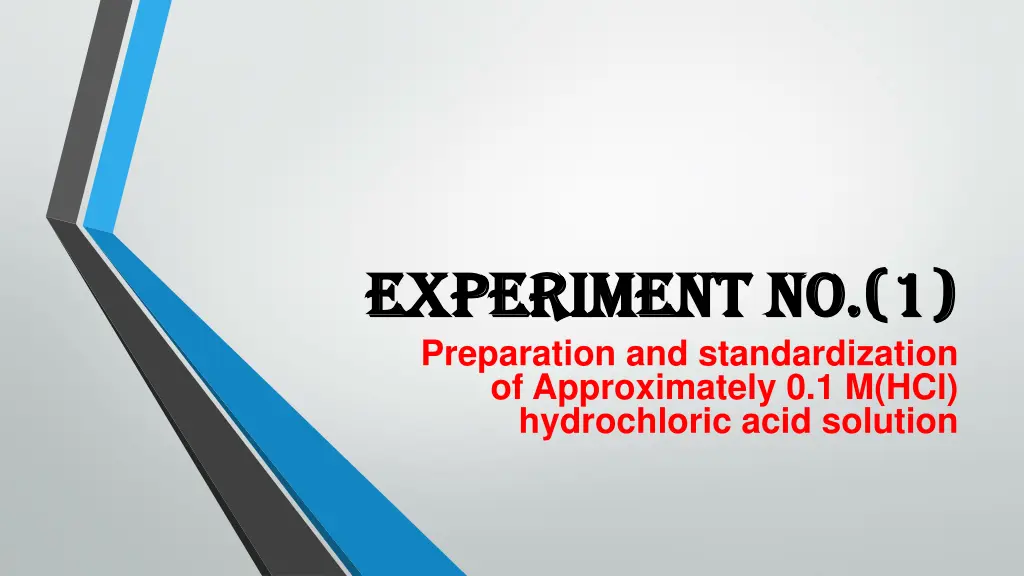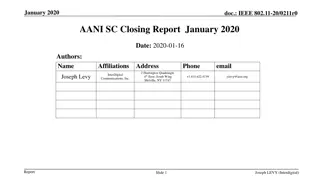
Hydrochloric Acid Solution Standardization Experiment
"Learn how to prepare and standardize a 0.1 M hydrochloric acid solution using sodium carbonate in this chemistry experiment. Understand the theory, procedure, and the use of primary and secondary standards. Get insights into the necessary calculations and steps involved."
Download Presentation

Please find below an Image/Link to download the presentation.
The content on the website is provided AS IS for your information and personal use only. It may not be sold, licensed, or shared on other websites without obtaining consent from the author. If you encounter any issues during the download, it is possible that the publisher has removed the file from their server.
You are allowed to download the files provided on this website for personal or commercial use, subject to the condition that they are used lawfully. All files are the property of their respective owners.
The content on the website is provided AS IS for your information and personal use only. It may not be sold, licensed, or shared on other websites without obtaining consent from the author.
E N D
Presentation Transcript
Experiment No.(1) Experiment No.(1) Preparation and standardization of Approximately 0.1 M(HCl) hydrochloric acid solution
Theory Hydrochloric acid is produced in solutions up to 38% HCl (concentrated grade). Higher concentrations up to just over 40% are chemically possible, but the evaporation rate is then so high that storage and handling need extra precautions, such as pressure and low temperature. Laboratory grade hydrochloric acid is not sufficiently pure to be used as a primary standard, because it evaporates easily. In this experiment, a standard solution of sodium carbonate is used to determine the exact concentration of a hydrochloric acid solution. The neutralization reaction that occurs is as follows:
Na2CO3 + 2HCl =2NaCl + H2 CO3 Na2CO3 HCL
primary and secondary standards primary and secondary standards primary primary secondary secondary Primary stander solution are solution made out of primary stander substances . Extremely pure (about 99.9 %). Less or not reactive . Not hygroscopic . Used standardize secondary standards and other reagent Secondary stander solution are solution made specifically for a certain analysis . Not very pure . Comparatively more reactive . Somewhat hygroscopic. Used for specific analytical experiments
Procedure Procedure . Preparing (50 ml) 0.1 M HClSolution:38 % HCL shows density 1.19 g/mL and we can find M by next Just an example : - M = sp.gr * % * 1000 M.wt Calculate the volume of HCl (conc.):-We must dilute it to preparing 0.1 M HClin 50 ml from next: (N* V) conc. = (N * V) dilute
Procedure Procedure 1-Preparing (50 ml) 0.1 M Na2CO3 Solution:-calculate amount from sodium carbonate for prepare 0.1 M in 50 ml M = Wt.(gm) /M.Wt.* 1000 /V(ml) 0.1 = Wt.(gm) 1000 106 50 * Wt. =0.53 gm
Procedure Procedure 2-Preparing (50 ml) 0.1 M Na2CO3 Solution:-calculate amount from sodium carbonate for prepare 0.1 M in 50 ml M = Wt.(gm) /M.Wt.* 1000/ V(ml) 0.1 = Wt.(gm)* 1000 /106* 50 Wt. =0.53 gm
Procedure Procedure Weigh 0.53 gm. from Na2CO3 in clean and dry beaker and dilute in 30 ml D.W, transfer solution to volumetric flask capacity 50 ml and complete the volume to the mark by D.W. 3. Transfer known volume of 5 ml the sodium carbonate solution, with a pipette, to a conical flask then add one or two drops of methyl orange to this solution.
Procedure Procedure 4. Add the acid unknown solution from the burette gradually with continuous swirling of the solution in the conical flask and near the end point, the acid is added drop by drop. Continue the addition of the acid until the color of the solution passes from yellow to faint red. 5.Repeat the experiment three times and tabulate your results then take the mean of the three readings.
Discussion Discussion 1.What the difference between primary and secondary standard substances? 2.Calculate the volume of conc. HCl required for preparing 250 ml 0.1 M? 3.Calculate the weight ofNa2CO3requiredforpreparing 100ml0.1 M? 4.Why is sodiumcarbonateprimarysolution? 5.Why standard solutionshould becolorless? 6.Why is HCl notprimarysolution? 7.Whatis the titration?



















